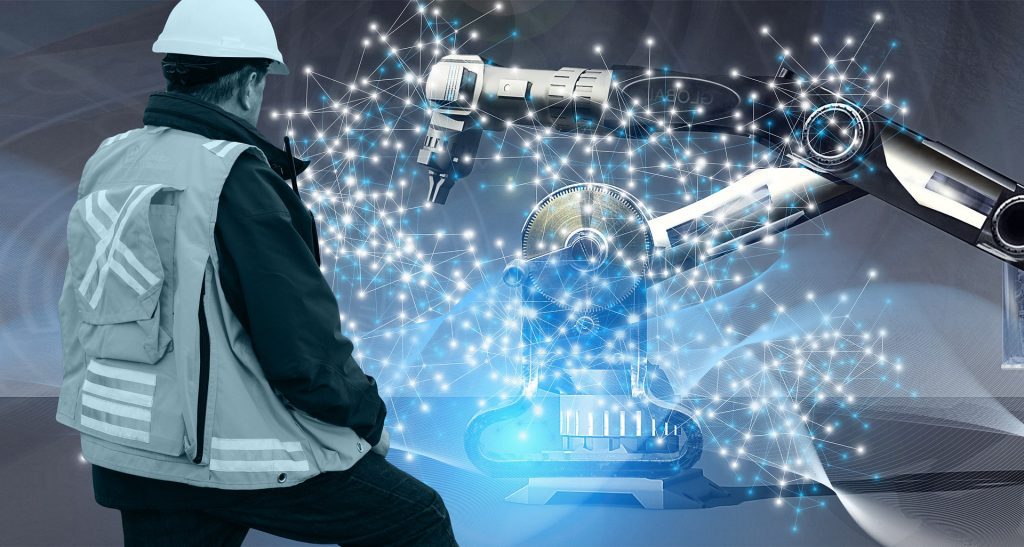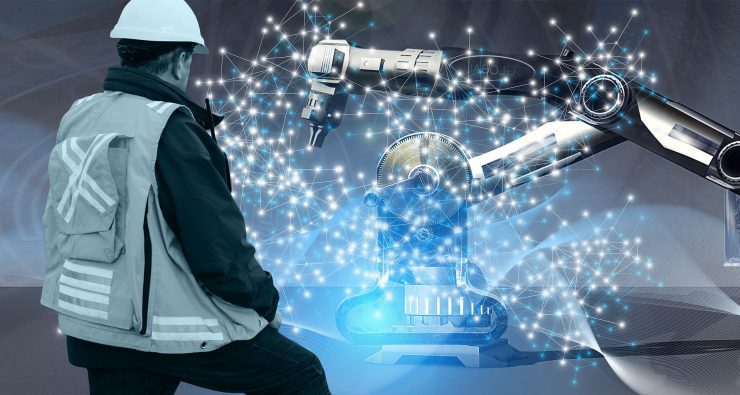5G and artificial intelligence (AI) are two revolutionizing industries, but the combination of 5G and AI is expected to be truly transformative. Adding to this transformation is the value of edge computing. While the concept of edge computing may not be revolutionary, its implementations are. Let’s explore this further.
The Connection of AI and 5G
It is said that 5G and AI are synergistic because: AI developments can help improve 5G system performance and efficiency, and the expansion of 5G connected devices can drive distributed intelligence with continued enhancements in AI learning and inference.
AI will strongly impact several key 5G network management areas: service quality, deployment, network efficiency, and network security. It can help overcome wireless challenges that are difficult to solve with traditional methods. At the same time, having knowledge of the wireless domain is necessary to determine when and where to apply AI’s capabilities.
5G was initiated in the cloud era, and it is explicitly designed for the Internet of Things (IoT), and it can connect billions of sensors to edge data centres for AI processing. 5G network can assist while AI runs for analysis of data, its fitting, clustering, and optimization, and it can be a facilitator and accelerator of the next industrial revolution in many ways, since it promises to deliver high data rates and ultra-low latency for applications.


Over a hundred mobile operators around the world have launched commercial 5G services, and many more are investing in and planning new 5G deployments. According to some findings, there is already a significant industry investment in integrating some aspect of AI into the 5G networks. In one research, Ericsson asked senior executives and decision-makers from 132 service providers worldwide, about their current plans for adopting AI into their networks. These are some of the company findings:
- AI is already being incorporated into networks, focusing on reducing capital expenditure, optimizing network performance and building new revenue streams.
- AI will be vital for improving customer service and enhancing customer experience.
- AI will help recoup the investments in communications service providers (CSPs) to switch to 5G.
- Adopting AI creates new data challenges, even as it solves network complexities.
This leads us to know about whether AI and 5G will meet the needs of society.
How are 5G and AI Addressing Different Industries’ Needs?
These technologies aim to improve the standard of living by reaching sustainability and increased innovation, followed by new or adjusted business models that include cost reduction and improved productivity.
In the following couple of years, AI is expected to transform every industry in a fast, secure, and cost-effective way, and the catalyst for this transformation is 5G. Which industry may benefit the most and how? Here are some sectors and practical examples you can learn about.


Healthcare – This industry is quickly evolving with the help of 5G, as it helps connect people in remote areas to doctors in other locations via real-time, high-quality video. Specialists can also remotely monitor patients from a different state or country, consulting with local doctors to assist in patient care where they would otherwise not be available.
Given the times we live in now, contact tracing and infection control have become significant concerns. The promise of low latency and faster data processing capabilities will enable more accurate and timely diagnosis in life-critical situations. At the same time, AI shapes healthcare services from self-monitoring tools and trackers to real-time feedback, combined with data analytics using electronic health records. These tools affect drug discovery, clinical research, information dissemination, and healthcare systems management.
Transport and logistics – Low latency is critical for autonomous vehicles to operate safely. 5G will enable augmented and virtual reality (AR/VR) technologies that will provide support on the road. VR could help a mechanic assist a driver that is stalled out in some area with essential repairs to get the truck back on the road, rather than wait for roadside assistance which could take hours or days. And 5G could help provide better visibility of goods while in transit, which is currently one of the biggest challenges in the logistics industry.
When we talk about the benefits of AI in this industry, particular interest in autonomous vehicles is showing in ride-sharing companies. Because of the customer service and labour productivity, these companies are exploring driverless cars. A typical example is the one from a few years ago between Volvo and Uber and the last one between Uber and Hertz for acquiring 50,000 Tesla vehicles.
Construction – 3D Building Information Modelling (BIM), simulator-type of digital twins of the buildings, drones and sensors on construction sites, and data analytics based on the real-time data collected on-site, are some of the business applications of AI in the construction industry. The industry is positioned to see a revolution through the use of 5G powered robotics and AR/VR to assist on-site workers in dangerous work situations, effectively improving safety.


Retail – Wholesalers, consumer goods manufacturers, e-commerce stores, supermarkets, shopping centres etc., are all under fast transformation today more than ever, and the power of 5G and AI has a significant impact on that process. Especially on retailers’ ability to deploy applications that optimize the customer’s shopping experience. Customers need a more convenient shopping experience with vast choices, a wide selection of similar offerings, and easy accessibility.
For example, retailers could allow customers to try on the latest styles virtually. Customers could walk through the manufacturing processes without being on-site. The benefits that retailers can gain from deploying the applications are cost and time efficiency due to improved supply operations, stock management, greater capacity for just-in-time production and delivery, increased sales, and broader market outreach.
Oil and gas sector – Safety monitoring, proactive asset maintenance, upstream automation and process automation are just some of the benefits in the oil and gas sector from the 5G and AI connection.
For example, video drones and robotic devices can use AI to conduct site inspections and recommend actions for oil platforms, pipelines and other hazardous worksites with more speed and accuracy while keeping humans out of potential danger. Like smart mining, innovative drilling operations with sensors, real data about the formations being drilled can help predictions. The percentage of companies in this sector that are considering or already investing in AI, is constantly increasing.
Adding the Edge Computing to the Synergy
One of the key trends and business drivers that will shape the roadmap of AI and 5G is edge computing. One simplified definition of edge computing is: “The practice of placing the computer and storage resources locally, closer to the end-user”.
The symbiotic nature of edge computing and AI is fascinating because artificial intelligence requires speedy data processing, which edge computing enables. Meanwhile, AI enables the higher performance of computing resources and intelligence at the edge. To scale intelligence efficiently, AI processing needs to occur closer to end-users on devices like smartphones, cars, laptops, or XR glasses. By processing data at the edge, we can realize better system efficiency, enhanced privacy, improved performance, and new levels of personalization.
To achieve ultra-low latency that may be needed, for example, for autonomous drones or remote telesurgery, the combination of 5G and edge computing will be necessary. Additionally, by leveraging the 5G technology, organizations would no longer be bound by network requirements when connecting to the cloud. In cases like this, they can focus on developing applications, and for data-heavy applications, sending data constantly back to the cloud will be expensive and deteriorate. Instead, data can be filtered out before being analyzed, rationalized, streamed and stored in the centralized cloud. In the long run, the question will not be 5G or edge computing, rather how to combine both technologies to deliver use cases.
Industries across the world can start leveraging the combination of AI, 5G and edge computing to collect enormous volumes of real-time data to enhance the existing operational system, improve productivity, and meet or create new customer experiences. Gartner expects that by 2025, 75% of all processing will happen at the edge.
Is there a Redline?


Any change comes with a set of unprecedented challenges, and with AI, edge computing, and 5G, it is no different. We highlighted some of the challenges:
Security – Data raises numerous security questions today. That’s why it is essential to safeguard users’ privacy or enterprise data without any compromise. Building a robust, secure infrastructure from systems to applications will be critical in 5G design and architecture. Having AI detect potential interference automatically is of utmost importance given the incredibly sensitive applications 5G will be trusted with.
Ethics – Failing to operationalize data and AI ethics leads to wasted resources, inefficiencies in development and deployment, and even inability to use data to train AI models at all. AI relies on massive amounts of data to operate, most of which contains private content. Missing the mark can expose companies to reputational, regulatory, and legal risks, but that’s not all. Despite the costs of getting it wrong, most companies grapple with data and AI ethics through ad-hoc discussions, with no clear protocol in place on how to identify, evaluate, and mitigate the risks.
Cultural challenges – AI and 5G acceptance within society will coincide with AI and 5G awareness. In this sense, educating citizens about these technologies is crucial. Users need to understand the process behind the decision, so AI and 5G must be trustworthy, transparent and visible in terms of every component, from differing cloud categories (public, edge etc.) to service types (video, IoT etc.). These cultural challenges are likely to arise in transitioning personnel and processes from manual work styles to more automated methodologies.
Biases – They are incorporated into algorithms and codes that power machine learning and AI systems. They can take various forms, such as gender bias, racial prejudice and age discrimination to name a few. Changing the algorithms will not happen fast and is not enough. There is a necessity to guarantee respect for human and digital rights. Being aware of the threats and seeking to minimize them is an urgent priority when many organizations are looking to deploy AI and 5G solutions.
Conclusion
The combined effect of 5G, AI, and edge computing will pave the path for new business models, innovation and opportunities across all industries.
There are already significant deployments in many industries and sectors, and we have listed some of them. The 5G and AI-driven developments in these, and many other industries, such as agriculture, education, marketing and advertising, finance, hospitality, architecture, and others, are generating substantial economic and social benefits so far. At the same time, all of these sectors can already experience improvement of the operational processes.
Last but not least, in this article, we have mentioned just some of the challenges during the process of improvements, such as culture, transparency, ethics, security, and biases. However, more (legal, financial, and managerial, among others) need to be addressed on time if society wants to witness the revolutionizing role of AI and 5G.















Add comment